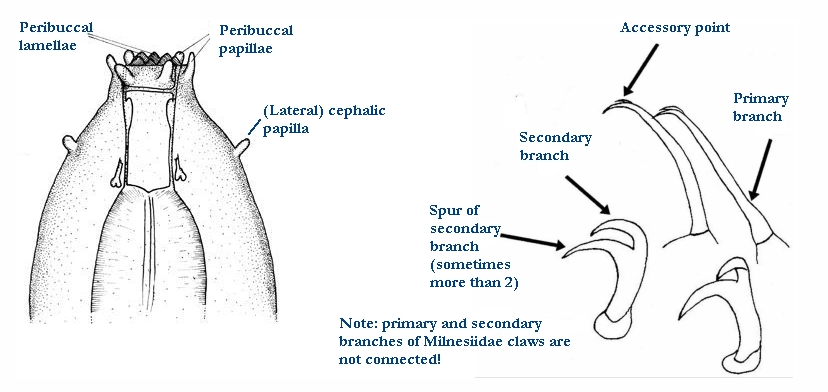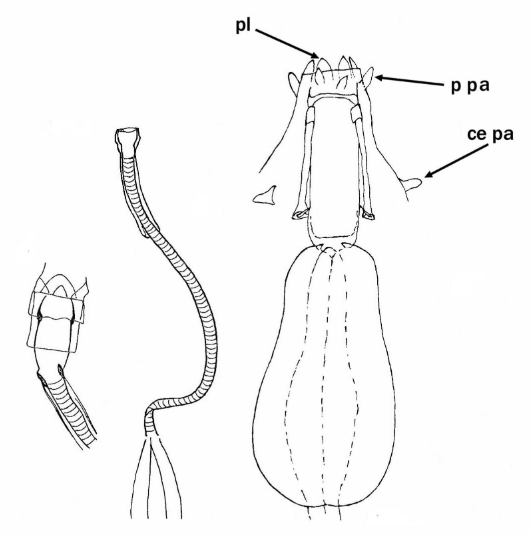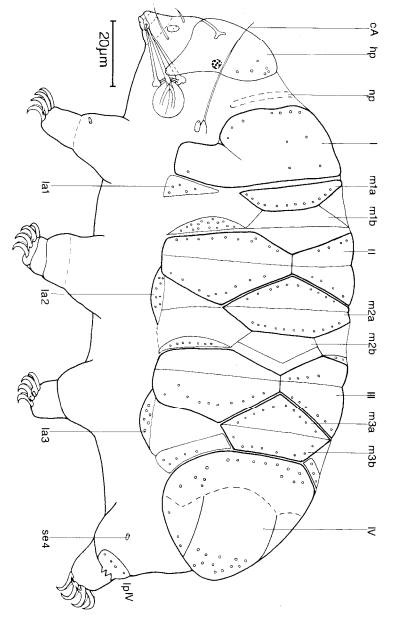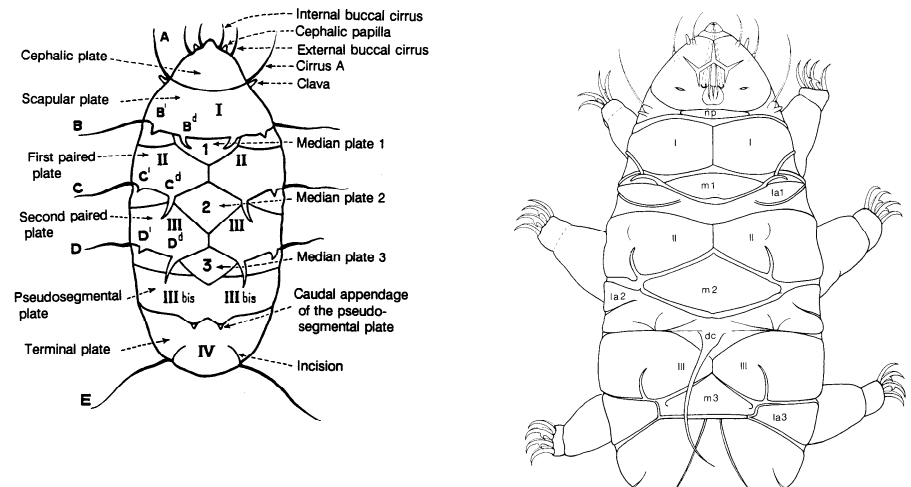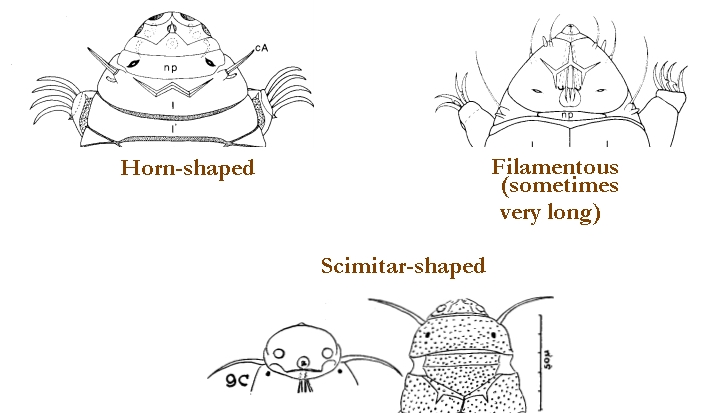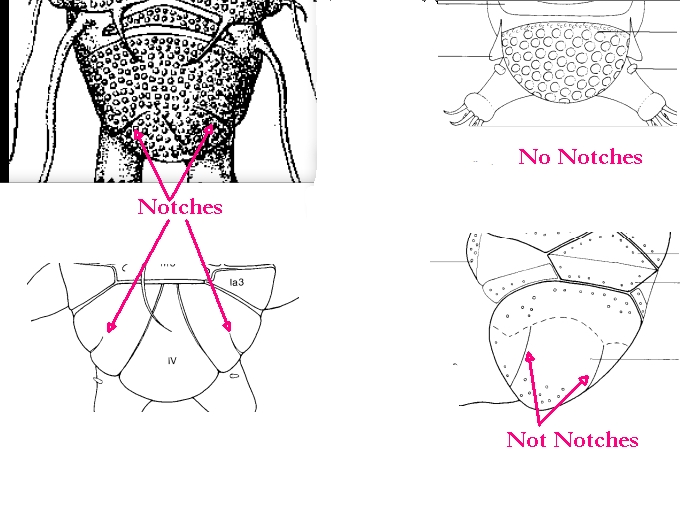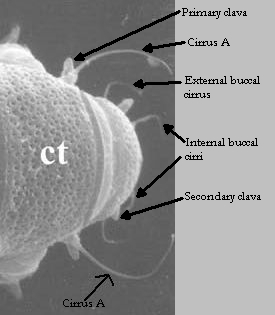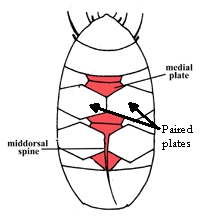Isohypsibioidea from Marley et al. 2011: “Parachela. Claws asymmetrical (2121); Isohypsibius-type claw pairs; AISM ridged.”
Isohypsibioidea from Bertolani et al. 2014: “Double claws asymmetrical with respect to the median plane of the leg (2121), normally with similar shape and size on each leg; double claws of the Isohypsibius type (secondary branch of the external claw inserted perpendicularly on the claw basal tract), or reduced from it: Hexapodibius type (very short, without common basal tract, with a base as large as the sum of the primary and secondary branch widths, and with an evident suture between primary and secondary branch); Haplomacrobiotus type (one branch only); completely absent (Apodibius). Buccal tube completely rigid (apart Paradiphascon; see below) and often relatively large, without (Dastychius, Eremobiotus, Halobiotus, Isohypsibius, Paradiphascon, Pseudobiotus, Thulinius) or with (Apodibius, Doryphoribius, Haplomacrobiotus, Haplohexapodibius, Hexapodibius, Parhexapodibius) ventral lamina. Eggs with smooth shell laid within the exuvium.”
Isohypsibiidae from Marley et al. 2011: “Isohypsibioidea. Claw pairs of similar size and shape. External and internal claws exhibiting articulation (the basal section and secondary branch form a solid unit while the primary branch and secondary branch articulate). Claws Isohypsibius-type, forming a right-angle between basal section and secondary branch. AISM ridge-like.”
Genus description from Pilato & Binda 1990: “Hypsibiidae con le due diplounghie di ciascuna zampa extremamente diverse fra loro; quella interna è di tipo Isohypsibius e quella esterna di tipo Hypsibius modificato (il ramo principale, estremamente lungo e sottile, non appare collegato all’unghia basale mediante un tratto sclerificato e flessibile ben definito). Apparato bucco-faringeo con tubo boccale rigido, privo di sbarretta di rinforzo ventrale e con le apofisi per l’inserzione degli stiletti a cresta molto lunga (esso risulta quindi molto vicino al tipo Isohypsibius); mancano lamelle periboccali ben sviluppate e l’organo sensoriale ellittico sul capo; il bulbo faringeo contiene apofisi e placoidi; nelle due specie finora ascrivibili al genere sono presenti alla base delle unghie ispessimenti cuticolari interpretabili come lunule anche se di forma diversa dal solito.”
Translated: Hypsibiidae with the two double-claws of each leg extremely different from each other; the inner one is of Isohypsibius type and the external one of Hypsibius type (the main branch, extremely long and thin, does not appear connected to the claw base by means of a well-defined sclerified and flexible tract). Bucco-pharyngeal apparatus with rigid buccal tube, without ventral reinforcement bar and with apophyses for the insertion of stylet muscles in the form of very long crests (it is therefore very close to the Isohypsibius type); without well-developed peribuccal lamellae and elliptic sensory organ on the head; the pharyngeal bulb contains apophyses and placoids; in the two species so far ascribable to the genus, cuticular thickenings are present at the base claws that can be interpreted as lunules although of a different shape than usual.
Citations :
Ramajendas image cropped from Miller WR, Horning DS, Dastych H. 1995. Tardigrades of the Australian Antarctic: description of two new species from Macquarie Island, Subantarctica. Entomologische Mitteilungen aus dem Zoologischen Museum Hamburg. 11 (152): 231-239.
“Parts” images from Pilato G, Binda MG. 2010. Definition of families, subfamilies, genera, and subgenera of the Eutardigrada, and keys to their identification. Zootaxa. 2404: 1-54.
Bertolani R, Guidetti R, Marchioro T, Altiero T, Rebecchi L, Cesari M. 2014. Phylogeny of Eutardigrada: New molecular data and their morphological support lead to the identification of new evolutionary lineages. Molecular Phylogenetics and Evolution. 76: 110-126.
Marley NJ, McInnes SJ, Sands CJ. 2011. Phylum Tardigrada: A re-evaluation of the Parachela. Zootaxa. 2819: 51-64.
Pilato G, Binda MG. 1990. Tardigradi dell’antartide: I: Ramajendas, nuovo genere di eutardigrado: nujova posizione sistematica di Hypsibius renaudi Ramazzotti, 1972 e descrizione di Ramajendas frigidus n. sp. Animalia. 17: 61-71.
Genus Ramajendas
Isohypsibioidea from Marley et al. 2011: “Parachela. Claws asymmetrical (2121);
Isohypsibius-type claw pairs; AISM ridged.”
Isohypsibioidea from Bertolani et al. 2014: “Double claws asymmetrical with respect to the median plane
of the leg (2121), normally with similar shape and size on
each leg; double claws of the Isohypsibius type (secondary
branch of the external claw inserted perpendicularly on the
claw basal tract), or reduced from it: Hexapodibius type
(very short, without common basal tract, with a base as
large as the sum of the primary and secondary branch
widths, and with an evident suture between primary and
secondary branch); Haplomacrobiotus type (one branch
only); completely absent (Apodibius). Buccal tube
completely rigid (apart Paradiphascon; see below) and often
relatively large, without (Dastychius, Eremobiotus,
Halobiotus, Isohypsibius, Paradiphascon, Pseudobiotus,
Thulinius) or with (Apodibius, Doryphoribius,
Haplomacrobiotus, Haplohexapodibius, Hexapodibius,
Parhexapodibius) ventral lamina. Eggs with smooth shell
laid within the exuvium.”
Isohypsibiidae from Marley et al. 2011: “Isohypsibioidea. Claw pairs of similar size and shape.
External and internal claws exhibiting articulation (the basal section and secondary branch form a solid unit while the
primary branch and secondary branch articulate). Claws Isohypsibius-type, forming a right-angle between basal
section and secondary branch. AISM ridge-like.”
Genus description from Pilato & Binda 1990: “Hypsibiidae con le due diplounghie di ciascuna zampa
extremamente diverse fra loro; quella interna è di tipo Isohypsibius e quella esterna di tipo
Hypsibius modificato (il ramo principale, estremamente lungo e sottile, non appare collegato
all’unghia basale mediante un tratto sclerificato e flessibile ben definito). Apparato bucco-faringeo con
tubo boccale rigido, privo di sbarretta di rinforzo ventrale e con le apofisi per l’inserzione degli
stiletti a cresta molto lunga (esso risulta quindi molto vicino al tipo Isohypsibius); mancano lamelle
periboccali ben sviluppate e l’organo sensoriale ellittico sul capo; il bulbo faringeo contiene apofisi e
placoidi; nelle due specie finora ascrivibili al genere sono presenti alla base delle unghie ispessimenti
cuticolari interpretabili come lunule anche se di forma diversa dal solito.”
Translated: Hypsibiidae with the two double-claws of each leg extremely different from each other;
the inner one is of Isohypsibius type and the external one of Hypsibius type (the main branch,
extremely long and thin, does not appear connected to the claw base by means of a well-defined sclerified
and flexible tract). Bucco-pharyngeal apparatus with rigid buccal tube, without ventral reinforcement bar
and with apophyses for the insertion of stylet muscles in the form of very long crests (it is therefore
very close to the Isohypsibius type); without well-developed peribuccal lamellae and elliptic sensory
organ on the head; the pharyngeal bulb contains apophyses and placoids; in the two species so far ascribable
to the genus, cuticular thickenings are present at the base claws that can be interpreted as lunules although
of a different shape than usual.
Citations
Ramajendas image cropped from Miller WR, Horning DS, Dastych H. 1995.
Tardigrades of the Australian Antarctic: description of two new species from Macquarie Island,
Subantarctica. Entomologische Mitteilungen aus dem Zoologischen Museum Hamburg. 11 (152): 231-239.
“Parts” images from Pilato G, Binda MG. 2010. Definition of families, subfamilies, genera, and
subgenera of the Eutardigrada, and keys to their identification. Zootaxa. 2404: 1-54.
Bertolani R, Guidetti R, Marchioro T, Altiero T, Rebecchi L, Cesari M. 2014. Phylogeny of Eutardigrada:
New molecular data and their morphological support lead to the identification of new evolutionary lineages.
Molecular Phylogenetics and Evolution. 76: 110-126.
Marley NJ, McInnes SJ, Sands CJ. 2011. Phylum Tardigrada: A re-evaluation of the Parachela.
Zootaxa. 2819: 51-64.
Pilato G, Binda MG. 1990. Tardigradi dell’antartide: I: Ramajendas, nuovo genere di
eutardigrado: nujova posizione sistematica di Hypsibius renaudi Ramazzotti, 1972 e descrizione
di Ramajendas frigidus n. sp. Animalia. 17: 61-71.





